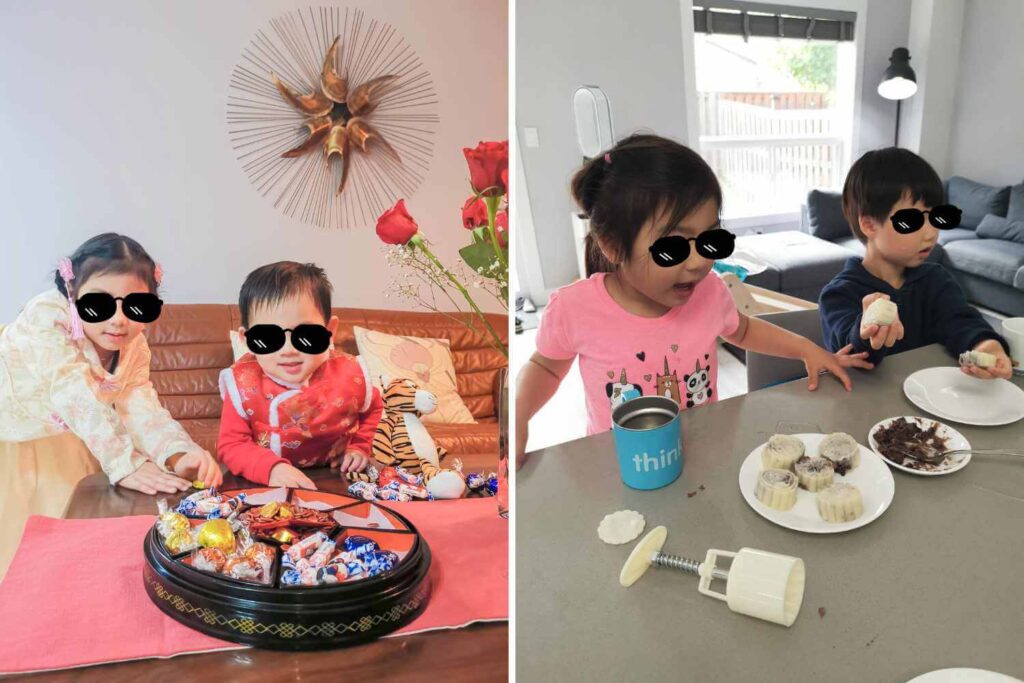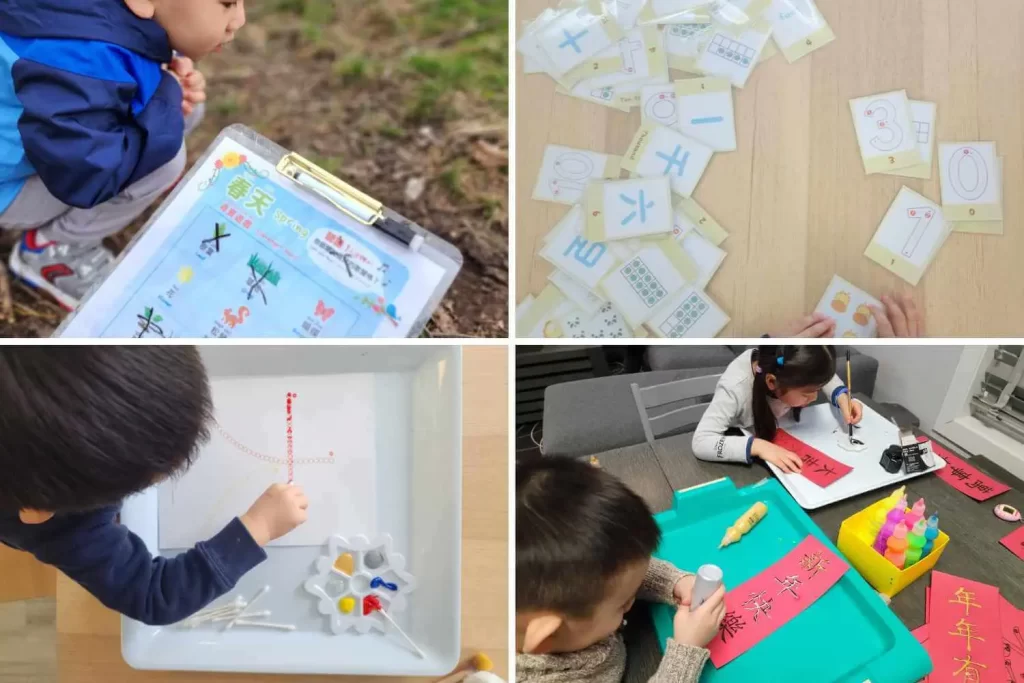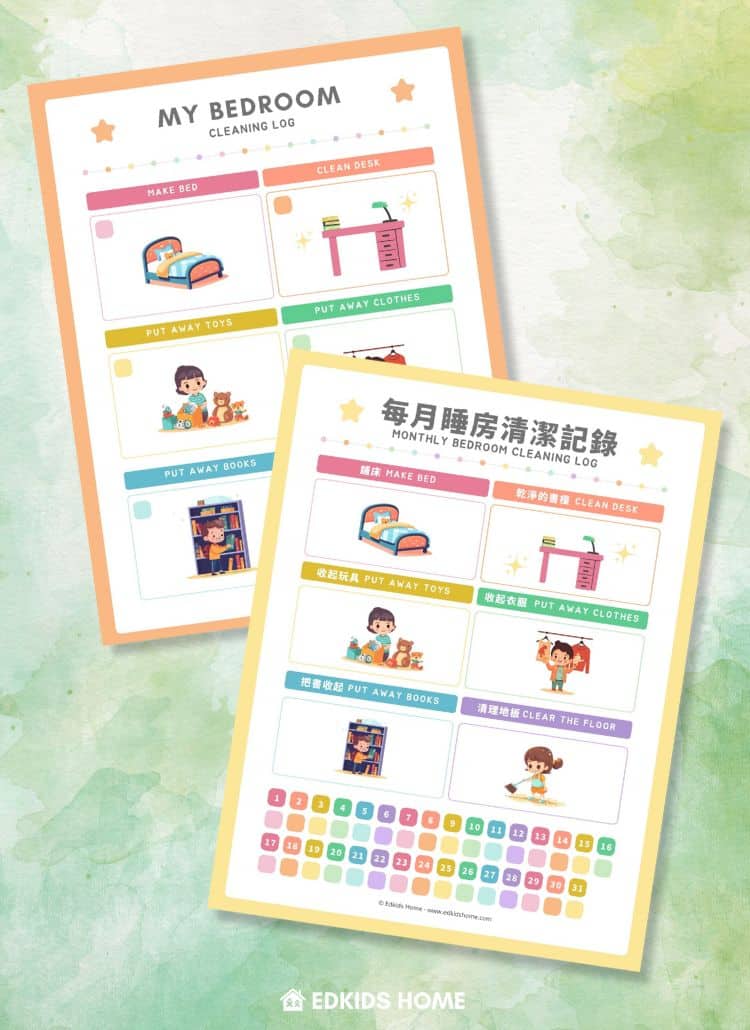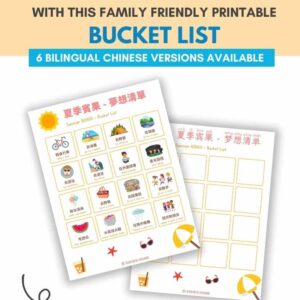
Are you facing the issue where your child is unwilling to speak or learn minority languages? Or are you searching for methods to improve your child's understanding of the minority language?
Teaching your child minority languages can be challenging, requiring dedication and commitment.
You want to ensure that both you and your child have fun while teaching the language, but you're not sure how to do so.
My Minority Language – Cantonese Chinese
My husband and I live in Canada, but our first language is Cantonese Chinese. We want to make sure our two kids learn about our culture, family history, and language. We have been speaking Cantonese to our daughter since she was born, as it is her first language. At that point, we haven't had any difficulty in assisting her in keeping her proficiency in Cantonese.
However, when she began attending her elementary school where English was the main language, she began speaking English frequently at home, causing a decline in her Cantonese abilities. This led me to consider ways to enhance our current situation.

I started by reflecting on my own childhood in Canada, specifically on how I became fluent in Cantonese and learned to read and write Chinese after immigrating at the age of 7. Additionally, I discussed the experiences of my bilingual friends and how their parents fostered their ability to speak their minority language. I interviewed several seniors who were able to raise fluent Canadian-born multilingual children successfully.
I asked them two essential questions: How do you guarantee your children become fluent in Chinese, and how do you keep them motivated to learn?
After hearing advices and we tried to apply them on our kids and we do slowly see results!
Then one day, we started receiving compliments from parents:
“Wow! Your kids speak Cantonese so well!”
“It's amazing that your kids can speak Cantonese fluently!”
I cannot express how I felt when I received those compliments. It was a moment when I realized that all the effort put into nourishing my kids' love for Chinese culture, heritage, and language was worth it! I felt so proud of my kids and super grateful to everyone who helped them to achieve this. It does take a village to do this!
And now, I would like to share 21 tips on how to teach minority languages to your kids and keep them motivated. You can teach your kids the language in a way that's enjoyable for them (and for you too!). Not only will it help strengthen the relationship between you and their kids, but it will also open up future opportunities for them down the line.
What is Considered a Minority Language?

A minority language is a language spoken by a group of people who are not the majority in their region or community. These languages can be used for communication between different communities, as well as being important sources of cultural identity.
The preservation and promotion of minority languages is an important part of protecting linguistic diversity around the world.
Is it Worth Learning a Minority Language?

Yes, it is worth it! Minority languages are important parts of cultures and help you to understand different ways of looking at things.
Connecting with people who speak a minority language can be very fulfilling and lead to more meaningful relationships. It is particularly true when you speak a minority language which is also your mother tongue. You share a unique connection with your family and friends who speak the same language as you.
Additionally, knowing minority languages can give you an advantage in some career fields. In the end, investing time in learning a minority language is a valuable investment in your future.
Furthermore, studies have shown that bilingual children are more cognitively flexible, and have improved memory and greater problem-solving skills.
21 Tips That Will Motivate Your Kids to Learn Minority Languages
Teaching your child minority languages when they are young is special and rewarding. They can learn about different cultures and gain good communication skills.
Here are 21 tips on how to teach minority languages to your kids effectively so they can reap the benefits of being bilingual or multilingual.
1. Figure Out Your Household Languages

When raising kids who can speak two or more languages, it is important to think about if the language spoken at home is one, two or more languages.
These are two common methods:
- Minority language at home (MLAH)
- One person one language (OPOL)
Minority Language at Home (MLAH)
If you and your partner have a shared heritage language, you may consider using this language as the primary language spoken in your household.
For example, both my husband and I are from Hong Kong. That is why Cantonese Chinese is our heritage language. We speak Cantonese with our children at home most of the time since it is a minority language in Canada. While our kids speak English in school with their friends and teachers.
One person one language (OPOL)
The one person one language method means that only one language should be used when speaking to a certain person. This might be between a husband and wife, or two people who are close.
Using two languages when speaking may confuse your child. This can be prevented by sticking to one language per parent.
For example, when the mom and dad come from different countries, they might speak different languages. The dad speaks Chinese and the mom speaks French. They will talk to their child in their language.
Most of the time, our family follows the MLAH approach. However, there are times when I switch to speaking English with them, specifically when reading English books and teaching English.
2. Start Early

Introduce your child to the minority language as early as possible, even before they are born. You can do this by singing songs and reading books in the minority language. This will give them a head start when it comes to learning the language.
3. Repeating, Paraphrasing, and Simplifying
Using language strategies such as repeating, paraphrasing, and simplifying language can also be effective. Try to use the language in a variety of contexts, such as during playtime or cooking together.
4. Avoid Frequent Code-Switching

Try not to mix two languages while speaking to your child, as this can be confusing and make it harder for them to learn both.
My husband and I used to mix English and Cantonese in our sentences, which we called “Ching-ish.” We also spoke this way to our kids.
However, we came to the realization that teaching our kids broken Chinese is not a beneficial habit, especially since we've observed that they struggle to speak the language fluently.
Therefore, we have made the decision to speak in full sentences in each language instead.
5. Prepare Your Home for the Minority Languages

If you create a minority language environment at home, it can help your child become immersed in the language.
There are a few things you can do to prepare your home for teaching your children the minority language:
- Speaking the minority languages in all aspects of everyday life, at mealtimes and during playtime, helps create a natural, comfortable atmosphere for learning the language
- Set up a library of books in the minority language.
- Create labels with the minority languages for common Items to pick up vocabulary.
- Display artwork & educational posters in the minority languages.
- Decorate the house in a way that integrates the traditions of the targeted culture during the holidays.
- Cook together that is related to your minority culture.
6. Surround Your Kids with People Speaking the Minority Languages

If someone in your family or friend speaks your minority language, surround your kids with them. Having different people who speak your minority language will help your child learn faster.
We feel thankful that our kids have both sets of grandparents and many other relatives who have better Cantonese language skills than my husband and me. Since we started letting our kids stay with their grandparents for one day per week, I have noticed a significant improvement in their Chinese proficiency and their love for Chinese culture.
If you can't find anyone, you can consider finding a tutor or nanny who speaks your minority language.
7. Make it Fun

Children learn best when they’re having fun. Try to make learning enjoyable by creating games or creative activities. This could involve flashcards, scavenger hunts, printables, or anything else you can think of.
Games can help children learn vocabulary and grammar more interactively.
Edkids Home offers a number of bilingual Chinese & English printables and activities for you and your kids.
8. Learn with Your Child

Learning a language is more enjoyable when you learn together with your kids! You can teach each other while bonding, and this can keep your child motivated to learn. This helps your kids pay attention and remember better!
Based on my 2 years of homeschooling experience, this approach is much more effective than the traditional teacher-student method.
I learned so much with my kids when it comes to playing activities and reading books with them. I believe this is my joy when I witness the moments my kids enjoy learning together with me.
These moments are so special and memorable to me and that is why I have created Edkids Home to spread the love to every parent.
9. Read Books

Reading books in their minority languages is another great way for kids to learn. This will help them learn new words and understand more about things.
When they start to enjoy reading, they will pick out their own books too. This helps them take control of their learning.
When your child learns a new language, they also learn about the culture it comes from. They learn how people think and act in that culture. This helps them to understand how different cultures can be.
Here are some websites you can buy Chinese books that I recommend:
- Amazon – This is the most convenient option to buy Chinese books.
- Seeds.com.hk – This is a Hong Kong-based online retailer that sells books, toys, games, and ship internationally.
- Books.com.tw – This is Taiwan’s largest internet retailer that has a large range of selection of books, movies, music, toys, clothing, and others.
- Kozzi.ca – This Canadian-based store has a collection of Cantonese Traditional Chinese books that ship to Canada & US.
10. Watch TV/Videos/Movies

Watching TV is not the primary source of language learning, but this is an excellent way for our children to catch on to the language naturally.
My husband and I have limited Chinese vocabulary. As a result, we have to depend on other sources to learn and expand our vocabulary together. This is where the TV comes in as a tool where we can learn together as a family.
Growing up, both my husband and I watched TVB dramas with our family and we strongly believe that this played a crucial role in helping us become fluent in Cantonese today. It also helped us maintain the culture of Hong Kong and retain our love for our hometown.
Disney+, Youtube, Prime, Netflix and TVB anywhere are amazing resources for our children since it has a number of different audio including Cantonese and Mandarin Chinese.
Related sources:
- 15 BEST Spring Videos and Songs for Kids to Learn: Chinese & English
- Everything You Can Teach Your Kids About Chinese New Year With Videos
11. Listen to Music & Podcasts

This is another fun way to help your children learn the language while spending time together. Listen to music together and talk about the lyrics. This is a great way to discover new vocabulary while enjoying quality family time.
Listening to podcast stories and music can help children learn new vocabulary and improve their listening skills. It can also be a fun way to learn about our culture.
One of the best times to play music and podcasts is during long car rides. We also have google home around the house where my children get to listen to songs/podcasts when taking a bath or eating breakfast.
Read: 15 Best Podcasts for Kids in 2023: English and Chinese Options
12. Utilize Learning Apps and Websites

There are all sorts of language-learning apps and websites that can be used to supplement your efforts. Look for ones that are specifically designed for children so they can learn in a fun and engaging way.
13. Continue Educating Yourself
You can educate yourself further on bilingualism. Many myths exist about raising a bilingual child, such as the false notions that bilingualism causes language disorders or learning disabilities, or that bilingual children get confused by being exposed to more than one language.
It has been proven that bilingual children reach important language milestones at the same rate as monolingual children, so the myths surrounding this topic have been debunked.
Multilingual parenting has recommended 15 books for parents and educators for raising bilingual children.
14. Join Minority Languages Parenting Communities
Joining a minority language parenting community can be beneficial for parents who are looking to raise their children in two languages.
By connecting with other likeminded families, parents can gain access to resources that can support the language learning process. These communities also provide both an emotional and educational basis of support – giving advice on various topics related to parenting and language acquisition as well as creating fun activities for children.
Joining a bilingual parenting community is an excellent way for families to foster a love for language and culture in their children.
Here are some Facebook groups for Bilingual Chinese parents I love:
- Cantonese Parents
- Raising Bilingual Children in Chinese & English
- Chinese Culture Resources for the GTA (Toronto)
15. Encourage Immersion by Traveling

This is an exciting journey in which you and your children will feel compelled to learn the language more quickly. It’s also a fantastic opportunity to discover more about the culture and see attractions.
The key factor that determines whether your children will be willing to learn your minority language is their interest in the culture and language.
Travelling to a country where people speak the same language as you can greatly motivate your kids to learn the language.
Each time I brought my daughter back to China, she developed a stronger passion for the country and became more eager to learn and speak Chinese.
Read more: How to Travel with Kids in China to Cultivate Chinese Interest?
If travelling is out of your budget, you can consider visiting local markets and malls with the targeted culture. For example, visiting Chinese supermarkets, malls, night markets, and so on.
16. Consider Bilingual Education
If your child is old enough to attend school, you may want to look into two-way immersion programs where classes are taught in two different languages and students of both language backgrounds are in the same classroom. This allows children to have consistent exposure to both languages across different subjects, and this can help them become proficient in both.
If your school district doesn't offer two-way immersion programs, there are other options to consider. After-school or weekend language classes provide a structured environment that can help with learning a second language.
Another option is to take a class together to understand the language alongside your children. This could be an online class or something offered at your local community centre. You can also take advantage of language immersion camps, usually offered during the summer or March breaks.
17. Learn About Minority Food, Culture and History

Understanding a language’s culture and history can be incredibly rewarding. Learning about the culture and history of a language can help to provide insight into how it is spoken, why certain words are used in certain contexts, and even help you pick up on local colloquialisms.
Exploring the culture and history of your target language can open doors to many more speaking opportunities, making your learning journey an enjoyable one!
Food is important in every culture. Different cultures have different ingredients, ways of cooking, and rules for eating meals.
For example, when you cook a traditional Chinese dish like stir-fried chicken, you can tell your children the story of how this dish came to be.
An easier way is to go to a Chinese restaurant where there may have Chinese decors and menus, which creates opportunities to teach Chinese to our children.
I have a friend who was born in Canada but has exceptional Chinese proficiency. This is because he has a vast knowledge of China's history and stories, which he gained from reading a large collection of Chinese novels and books. His parents supported his interest by providing him with more books to fuel his love for the genre.
18. Consistency
Consistency is key when it comes to teaching a child a minority language. Make sure to speak the language consistently with your child and use it in everyday conversations at home.
19. Set Realistic Goals
Setting realistic goals is an important factor in any language learning journey. It is a good idea to start off with achievable, short-term goals and then gradually increase the complexity of your goals as you further advance.
These could include setting a target number of words you want to learn each day or week or aiming for a certain level on proficiency exams.
Most importantly, make sure that the goals are realistic and specific – this will help keep motivation levels high and ensure that progress is made.
20. Be Patient and Encouraging
it’s important to be patient and encouraging with your child as they learn the minority language.
Don’t expect them to become fluent overnight, and try to create a positive and supportive learning environment that encourages them to continue practising and using the language as much as possible.
21. Find Bilingual Friends

Finding bilingual friends is a great way to practice speaking and understanding a new language. Bilingual friends can not only help with pronunciation but also provide insight into cultural nuances that may be difficult to pick up on your own.
Immersing yourself in the culture by talking to locals or joining local events is a great way to meet new people and even make some longterm friendships.
As a Chinese Canadian who grew up in Canada, one of the most important things I've learned is the importance of having friends who share your cultural background, and who speak your minority language.
I feel so fortunate to have met some great friends in high school (who are now my best friends) who also speak Cantonese. We share so many interests, from watching Cantonese dramas to admiring Chinese celebrities, and even teaching Cantonese to our children! My friends are a cornerstone of my life and have helped me stay connected to my Chinese heritage.
Last Thoughts About Learning the Minority Languages with Your Children?

Here are 21 tips for encouraging your kids to love and learn a minority language:
- 21 Tips That Will Motivate Your Kids to Learn Minority Languages
- 1. Figure Out Your Household Languages
- 2. Start Early
- 3. Repeating, Paraphrasing, and Simplifying
- 4. Avoid Frequent Code-Switching
- 5. Prepare Your Home for the Minority Languages
- 6. Surround Your Kids with People Speaking the Minority Languages
- 7. Make it Fun
- 8. Learn with Your Child
- 9. Read Books
- 10. Watch TV/Videos/Movies
- 11. Listen to Music & Podcasts
- 12. Utilize Learning Apps and Websites
- 13. Continue Educating Yourself
- 14. Join Minority Languages Parenting Communities
- 15. Encourage Immersion by Traveling
- 16. Consider Bilingual Education
- 17. Learn About Minority Food, Culture and History
- 18. Consistency
- 19. Set Realistic Goals
- 20. Be Patient and Encouraging
- 21. Find Bilingual Friends
Teaching your kids your minority language is an amazing opportunity. It can help your kids get more opportunities in life. Sure, it takes a lot of work and patience from both you and your kids, but it's totally worth it in the end. My own Cantonese skills have improved a ton since I started learning Chinese with my little ones. So don't give up, keep at it!加油!Write a comment below if you have more tips to share.





So many helpful tips! I am working on incorporating more Chinese into our daily lives so these are a helpful reminder of what I should do. 🙂
Thank you for your comment, Pauline! I’m glad you find our article useful. You are doing amazing job though! And yes, I’m also trying to remind myself of what to do as a parent to enhance our bilingual learning! Let’s keep working hard together XD!